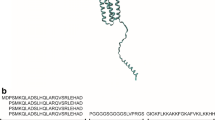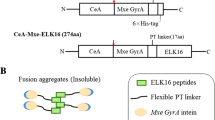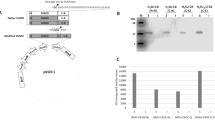Abstract
Antibacterial peptide CM4 (ABP-CM4) is a small cationic peptide with broad-spectrum activities against bacteria, fungi, and tumor cells, which may possibly be used as an antimicrobial agent. To improve the expression level of CM4 in Escherichia coli, two tandem repeats of CM4 genes were cloned into the vector pSUMO to construct an expression vector pSUMO–2CM4. The fusion protein SUMO–2CM4, purified by Ni2+-chelating chromatography, was cleaved by hydroxylamine hydrochloride to release recombinant CM4. After the cleaved sample was re-applied to a Ni-IDA column, finally, about 48 mg recombinant CM4 was obtained from 1 L bacterial culture with no less than 96% purity, which was the highest yield of CM4 reported so far.




Similar content being viewed by others
References
Boman HG (2003) Antibacterial peptides: basic facts and emerging concepts. J Intern Med 254:197–215
Butt TR, Edavettal SC, Hall JP, Mattern MR (2005) SUMO fusion technology for difficult-to-express proteins. Protein Expr Purif 43:1–9
Chen YQ, Zhang SQ, Li BC, Qiu W, Jiao B, Zhang J, Diao ZY (2008) Expression of a cytotoxic cationic antibacterial peptide in Escherichia coli using two fusion partners. Protein Expr Purif 57:303–311
Kagan BL, Selsted ME, Ganz T, Lehrer RI (1990) Antimicrobial defensin peptides form voltage-dependent ionpermeable channels in planar lipid bilayer membranes. Proc Natl Acad Sci USA 87:210–214
Makovitzki A, Avrahami D, Shai Y (2006) Ultrashort antibacterial and antifungal lipopeptides. Proc Natl Acad Sci USA 103:15997–16002
Moks T, Abrahmsén L, Holmgren E, Bilich M, Olsson A, Uhlén M, Pohl G, Sterky C, Hultberg H, Josephson S (1987) Expression of human insulin-like growth factor I in bacteria: use of optimized gene fusion vectors to facilitate protein purification. Biochemistry 26:5239–5244
Pyo SH, Lee JH, Park HB, Cho JS, Kim HR, Han BH, Park YS (2004) Expression and purification of a recombinant buforin derivative from Escherichia coli. Proc Biochem 39:1731–1736
Rao XC, Li S, Hu JC, Jin XL, Hu XM, Huang JJ, Chen ZJ, Zhu JM, Hu FQ (2004) A novel carrier molecule for high-level expression of peptide antibiotics in Escherichia coli. Protein Expr Purif 36:11–18
Shin SY, Kang JH, Lee DG, Jang SY, Seo MY, Kim KL, Hahm KS (1999) Influences of hinge region of a synthetic antimicrobial peptide, cecropin A(1–13)-melittin(1–13) hybrid on antibiotic activity. Bull Korean Chem Soc 20:1078–1084
Skosyrev VS, Rudenko NV, Yakhnin AV, Zagranichny VE, Popova LI, Zakharov MV, Gorokhovatsky AY, Vinokurov LM (2003) EGFP as a fusion partner for the expression and organic extraction of small polypeptides. Protein Expr Purif 27:55–62
Sugiarto H, Yu PL (2004) Avian antimicrobial peptides: the defense role of beta-defensins. Biochem Biophys Res Commun 323:721–727
Xu J, Zhang SQ (2001) The mechanism of antibacterial peptide CM4 component was observed by confocal laser scanning microscope. Prog Nat Sci 10:1105–1109
Xu J, Zhang SQ (2001) The research of the mechanism of antibacterial peptide CM4 component against A. parasiticus. Prog Nat Sci 11:1263–1267
Xu Z, Zhong Z, Huang L, Peng L, Wang F, Cen P (2006) High-level production of bioactive human beta-defensin-4 in Escherichia coli by soluble fusion expression. Appl Microbiol Biotechnol 72:471–479
Zhou LF, Zhao ZH, Li BC, Cai YF, Zhang SQ (2009) TrxA mediating fusion expression of antimicrobial peptide CM4 from multiple joined genes in Escherichia coli. Protein Expr Purif 64:225–230
Acknowledgements
This work was supported by the Grants of Nanjing Normal University and Jiangsu Province Graduate Innovation Project (No. CX07S-020z) administered by Prof. Zhang. This work was financially supported by National Nature Science Foundation of China (No. 30270193) and Natural Science Foundation of Jiangsu Province, China (No. BK2006221).
Author information
Authors and Affiliations
Corresponding author
Rights and permissions
About this article
Cite this article
Li, J.F., Zhang, J., Zhang, Z. et al. SUMO Mediating Fusion Expression of Antimicrobial Peptide CM4 from two Joined Genes in Escherichia coli . Curr Microbiol 62, 296–300 (2011). https://doi.org/10.1007/s00284-010-9705-3
Received:
Accepted:
Published:
Issue Date:
DOI: https://doi.org/10.1007/s00284-010-9705-3




